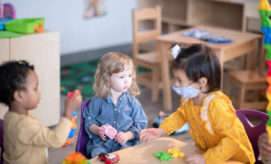This past year, children’s lives have changed significantly, due to the COVID-19 pandemic. Opportunities for learning and social interaction have shifted from in-person to virtual experiences, as children spend more time at home. Many families have noticed increases in the amount of time that children are spending using devices.
From virtual learning and playing games to streaming tv shows and facetiming loved ones, there is no doubt that young children’s screen-time has increased over the past year. But, what do experts say about these experiences? Have mindsets about screen time shifted over the past year as a result of the pandemic?
A Matter of Quality and Quantity
Before COVID-19, the recommendations about screen time were kept fairly strict. Experts advised limiting children’s screen time in favor of activities like socialization, reading, and play. Ideally screen time with very young children happens as part of an interaction with an adult, such as reading a story or talking together.
The pandemic has caused those recommendations to be revisited, in an effort to help families adapt to the challenges of sheltering in place and social distancing. Phoenix Children’s Hospital recently published an article that compares screen time guidelines before and after the onset of the COVID-19 pandemic:
“Traditionally, the recommendations have been clear: no screen time prior to the age of 2, only one hour of screen time per day for children ages 3 to 10 and only two hours of screen time per day for children ages 11 to 13. Enter the COVID-19 pandemic…While the AAP (American Association of Pediatrics) does not give a new number of recommended hours of screen time, they instead focus more on quality and content of screen time. Parents should remember quality matters because not all screen content is of equal value. ”
Self-Compassion for Parents
The American Academy of Pediatrics (AAP) shared an article written by Corinn Cross, MD, FAAP that notes “while limits are still important, it’s understandable that under these stressful circumstances, kids’ screen media use will likely increase.” Because parents have been overwhelmed, they should cut themselves some slack regarding changes in their children’s screen time routines.
This message was echoed in an article written by Annabelle Timsit for Quartz, who reminded parents to, “have a bit of self-compassion, and acceptance for you and your kids…It’s a tough time for everyone, but especially for those whose kids are young, and by definition, very demanding.”
The Importance of a Daily Plan
As children engage in virtual learning, it is inevitable that they will be spending longer than the typically recommended periods of time on their screens, so having a plan is important. Phoenix Children’s Hospital advises that, “The world has changed (for the time being) and those previous recommendations may not be feasible…This doesn’t mean throw caution to the wind, but instead, it means parents are recommended to create a daily plan which structures exactly how much and when screen time will be accessible.”
Making the Plan
Having a daily screen time plan and schedule is a good way for parents to ensure that children also have enough time for sleep, physical activity, reading, and spending time with family.
So what does a daily plan look like? The AAP has created a tool that can be used for making a personalized family media plan, which can be found here. The tools helps families to create a plan that is in line with their values and parenting style. The AAP also has a list of tips that include keeping screens out of children’s bedrooms, co-viewing programs with them, monitoring the websites that children are viewing, and setting a curfew.
Creating Tech-Free Zones
NAEYC suggests that family digital media and screen time plans include “tech-free zones and times, including no media use during meals and one hour before bedtime.” These limits help build in time for important developmental experiences.
Tech-free time plans can include activities for learning and play, such as drawing a picture, doing a puzzle, or taking a walk around the neighborhood. Encouraging and allocating time for imaginative play is also valuable.
The predictability of daily routines was lost at the start of the pandemic. It is easier for children to return to needed structure when their schedule includes time for fun and play.
Selecting the Content
Using trusted sources such as: Common Sense Media (which suggests dance games and other active apps, websites, and video games for families) will also help families select high-quality, developmentally-appropriate on-screen content for their children. There are many media options that are educational or that model values like empathy and racial and ethnic tolerance.
The AAP’s policy statement on media notes that “well-designed television programs, such as Sesame Street, can improve cognitive, literacy, and social outcomes for children 3 to 5 years of age…Evaluations of apps from Sesame Workshop and the Public Broadcasting Service (PBS) have shown efficacy in teaching literacy skills to preschoolers.”
Screen Time: Potential Risks
One of the biggest risks of extended periods of time on a screen is what children are missing. When children are in front of a computer, they can be missing out on important developmental and learning experiences, such as exploring outdoors, enjoying social interactions with family members. While screen time can be beneficial, it is important that it doesn’t take away from these activities.
The AAP adds that screen time can negatively impact children’s health. Excessive screen time puts children at higher risk of obesity, poor sleep, and poor executive functioning. Children who spend too much time on a screen are also more likely to experience delays in cognitive, language, and social/emotional development. These risks increase as screen time increases, so limiting screen time is critical for healthy development.
Additional Resources





